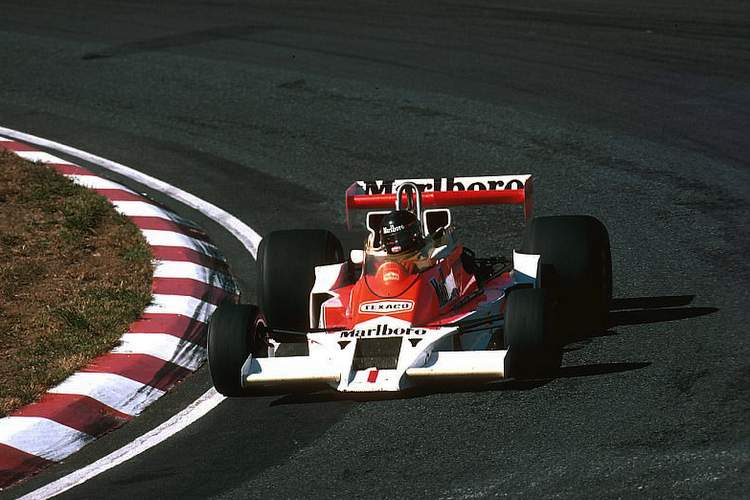These could also interest you

James Hunt's final Formula 1 victory
James Hunt's tenth Formula 1 victory at the 1977 Japanese Grand Prix also happened to be his last at the pinnacle of the sport. This is how it unfolded,
Read More

James Hunt's tenth Formula 1 victory at the 1977 Japanese Grand Prix also happened to be his last at the pinnacle of the sport. This is how it unfolded,
Read MoreWhen James Hunt signed to replace Emerson Fittipaldi at the powerhouse McLaren team in 1976, his first Formula 1 race for the team also happened to be his first win for the Marlboro backed team.
Traditionally, the Race of Champions was an annual non-championship race held early every season. In 1976 the RoC took place at Brands Hatch, a week after the South African Grand Prix and shortly before the cars were shipped to Long Beach for round three of that year’ F1 World Championship.
Typically, F1 teams would send one car and mix it up with privateers as well as Formula 2 and Formula 5000 entries in what was essentially a Formula Libre race.
Thus, on 15 March 1976 a stellar cast that included James, who having departed Hesketh at the end of 1975, unexpectedly signed replace 1974 World Champion Emerson Fittipaldi at Teddy Mayer’s McLaren after Fittipaldi was lured to join his family team Copersucar. by big money
With McLaren driverless and James carless, a deal was struckto see Hunt become part of one of the strongest teams on the F1 grid at the time.
While his signing was unexpected, Hunt had in retrospect matured into a solid and ultra-fast driver with Lord Hesketh's crazy rock 'n roll team, but that adventure had its limitations and was fast running out of money by 1974. James was on the other hand destined for bigger things.
On home soil with a skyrocketing reputation, especially in Britain, James Hunt had nowhere to hide – he was in the full glare of the spotlight as his Hunt’s arrival at McLaren attracted huge attention to the Brands Hatch race.
Ferrari sent Niki Lauda in the 312T2, the Austrian in his second year at the Italian team, while Gunnar Nilsson was on duty in the JPS Lotus 77, Jody Scheckter was entered in the Tyrrell, Carlos Pace for Brabham, Alan Jones was in the Surtees had, Tom Pryce the Shadow, while John Watson was there for Penske and Jacky Ickx was in a Frank Williams run Hesketh making up the cream of the 20-car grid crop.
Lauda had already won both the Brazilian and South African Grands Prix, while Hunt has retired at Interlagos but bounced back to take second at Kyalami. He was uncomfortable with the M23 and was in and out the pits as he swapped between his race and spare cars while Scheckter set a blistering pace in qualifying - two seconds faster than closest rival Lauda, with James 3.4 seconds adrift to start from fifth on the grid.
Reporting for Motorsport Magazine, the great Denis Jenkinson pointed out that: "James Hunt was anything but idle, having two McLarens at his disposal, M23/8 and M23/6, and continual engine trouble kept the blond Englishman on his toes, walking or running back to the pits to change cars."
The doyen of motorsport journalism added: "With Hunt in row three and absolutely bursting with confidence and eagerness... (he) wasted no time crying over his miserable practice and poor grid position, and was in second place (in the race) by the end of lap 2, followed by Nilsson, Lauda, Watson, Evans and Brambilla."
So a young Alan Jones led in the Surtees, with Hunt second and expecting the leader to break down but James realised that he would have to attack the up-and-coming Australian, leaving Jenkinson to immortalise the battle for the lead in his inimitable style: "On the twentieth lap, or half distance, Hunt felt he had been in second place long enough, but more to the point, he realised that not only was Alan Jones not going to make a mistake, but the Surtees was not going to break, nor was it going to slow down.
"Along the new Bottom Straight, he got the McLaren alongside the white Surtees, but still Jones was not impressed, and side-by-side they headed for the tight left-hand bend, both on the wrong line, and both braking hopelessly too late – it was great stuff to watch.
"As they scrabbled into the corner on a wide line, Hunt on the inside, the McLaren driver regained control of the situation a fraction of a second, and milliseconds really were involved, before the Surtees driver and swung up the hill in the lead.
"Afterwards Hunt admitted frankly that they ‘seemed to be committed to both going off the road, but by chance he managed “to gather it all together again” a fraction sooner than Jones did.
"It was no dishonour to the young Australian that he was now second, far from it in fact and, conscious that James Hunt had out-driven him, he was more than happy to hold a certain second place right through to the finish."
So, against all pre-race expectations, James Hunt won the Race of Champions with the same dogged grit and determination that would serve him well with the epic duel against Lauda set to unfold through the year beyond that Brands Hatch weekend.
The Race of Champions also proved that Ferrari was fallible – Hunt’s Austrian rival was forced to retire his car with engine woes, while James simply kept his head down to delivere when it mattered.
His first victory for McLaren set the stage for what would become his year with Jenks calling it like the Nostradamus of his time: "It was significant and the McLaren team went away more confident than ever that the only thing to do about Lauda and the Ferrari is to beat them fair and square."
How true, Mr Jenkinson!

